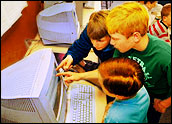
As the country gears up for the November elections and online communities start to buzz, it’s instructive to look back at the way image myths were created, even with the openness of the Internet. The Howard Dean campaign is one example.
During the 2004 election, the Dean campaign was credited with using the Internet in new ways, reaching out to voters many assumed were college youth, otherwise disconnected from politics.
A Clear Picture
“Dean’s presidential campaign was remarkable at the time for its extensive use of the Internet to reach out to its supporters,” a Wikipedia summary now notes. “The candidate’s staff, and occasionally even the candidate, frequently ‘blogged’ while on the campaign trail and even sought advice on important campaign-related decisions — in at least two instances even making decisions through online polls of supporters.”
Dean’s approach was certainly innovative at the time, but what most people didn’t realize was that his supporters were not generally the disengaged college campus youth who wouldn’t have been involved if not for Dean’s Net tactics. Instead, Pew Internet Research reports in a 2005 study that “the group’s overall age distribution” was “fairly close to that of Democrats in the general public.” They were also “far wealthier” than general Democrats and were not the most frequent Internet users.
Indeed, a 2004 Pew report noted that while only 64 percent of Dean supporters reported generally using the Internet, 67 percent of supporters of “all other” candidates in the 2004 presidential election used the Net. But the Dean campaign isn’t the only example of perception deviating from reality. Consider the so-called “netroots,” a left-wing movement organized around blogs that seeks to “take back” America.
One might be tempted to assume the netroots are young people organizing to fix their parents’ mistakes to ensure a better future for themselves. That doesn’t appear to be the case.
Reality-Perception Mismatch
According to a 2006 survey by comScore Media Metrix, netroots members at flagship blog DailyKos are positively grey-haired. The survey states, “the demographic snapshot of DailyKos.com readers reveals that while all adult age groups are represented, there is a very large skew toward adults 65 and older. In fact, this age group is nearly four times as likely as the norm to visit the site.”
An educated guess says this is also true for Moveon.org, the Democratic political mobilization machine. While the Moveon.org Web site doesn’t offer demographics, its founders are both pushing 50, being born in 1960 and 1956.
It’s fascinating that many of the left’s online activists are actually graying hippies, but there’s a larger lesson in the very obvious mismatch between reality and perception. That is, it is clear that even though the Internet is a relatively open medium, perceptions can still be “managed” or skewed just like they are in the offline world. This brings into question just how useful the Internet really is for advancing democracy in countries like America where speech is relatively free and elections are frequent.
Examine the Source
Perhaps the over-hyped idea of the Net as a vehicle of democracy should be recognized as a remnant of the Internet bubble and we should all truly move on to the reality that perceptions can be spun in any medium. This of course means that decisions can be skewed too, although that wasn’t the case with Howard Dean. When Dean lost the Democratic nomination, many expressed surprise because his offline performance didn’t seem to match the online glamour.
In the upcoming election, voters should take more time to examine their online sources. One never knows where aging hippies or some other such group will disguise themselves next.
Sonia Arrison, a TechNewsWorld columnist, is director of Technology Studies at the California-based Pacific Research Institute.




















































